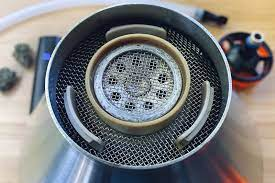
The conduction vs convection debate is ongoing. Just check any forum for weed vapes. This article doesn’t aim to settle it; that’s a tall order. Its purpose is to explain the different ways a vaporizer can heat up your bud, and help you find out what type of heating is a better fit for your needs. In a nutshell: conduction uses surface heat, convection uses hot air, and there’s also hybrid heating which is a blend of the two. The differences may not seem major, but each has its own pros and cons that can help you choose.
Let’s take a closer look at the fundamentals behind these heating methods before comparing them.
Conduction
Thermal conduction takes place through direct contact—a heat source touches the body of a colder element and transfers heat to its surface. Pans, kettles, and pots heat through conduction. Heat transfers from the stove to their surfaces, and then what’s inside.
In vaporizer terms, conduction works by applying direct heat from a heating element to the chamber, and then to the surface of your bud. If you think that that’s too simple, well, you’re right. The simplicity and lower cost needed to implement this technology is the reason most herb vaporizers are in fact conduction units.
Convection
Convection is the transfer of heat from one place to another due to the movement of fluid. Remember, air is a gas, and gasses are fluid. Heating an element with the use of heated up air is in fact thermal convection. A good example is a convection oven. Turning up the fan guides hot air around your food, cooking it evenly without a heating element being in direct contact with it.
On a vaporizer, convection works in a variety of ways. The most commonly used heating methods for desktop vaporizers are the fan/balloon method (popularized by the Volcano) and the whip. The former uses a fan to guide hot air in the chamber which fills up a balloon, while the latter uses lung power to channel warmed-up air through a hollow cable. As for portable vaporizers, “real-convection” units allow for some distance between the chamber and the heating element. The air you draw in with your puff is heated and guided into the chamber, vaporizing your herb uniformly.
Hybrid
As its name suggests, hybrid heating blends characteristics of both convection and conduction. The extent that a device uses each of the two varies, but in most cases, a hybrid vape will heat your bud by warming incoming air while at the same time heating up the chamber to ensure more thorough vaporization. If you want yet another cooking metaphor, think of it like this: starting a steak in a convection oven, finishing it on the griddle. In theory, this seems to be the best of both worlds—and some vapers would argue that their hybrid device offers the most efficient vaporization possible.
But let’s set buyer’s bias aside for now, and let’s see how the different types of vaporizers compare to each other.
Convection vs conduction vs hybrid vapes
If you just want to know what’s best, you guessed it: there is no straight answer to that question. All three types of vapes have die-hard fans and it mainly depends on how you vape and what you prioritize on a dry herb vape.
If you enjoy vaping a full bowl in a session and want the most oomph out of your vape, then conduction may be what you’d prefer. Conduction vaporizers will reach a certain temp and keep it steady there, so on-demand vaporization becomes a bit challenging to pull through. But this steady heating of your bud will produce thick clouds—just make sure you watch out for combustion! When using conduction vaporizers, stirring your herb inside the chamber is of paramount importance. Depending on the heat setting, you may even need to stir after every hit, which is something that many users may find cumbersome.
Also, if price is a factor, you should know that conduction vapes are generally cheaper. If you see a sub $100 tag on a vaporizer, there is a high chance that it is a conduction vape. Also note that with conduction being a relatively simple technology, it is a great fit for smaller portable vaporizers. Can your vaporizer easily fit inside your palm? Then it’s probably a conduction unit.
Conduction: pros & cons
·Generally cheaper
·Allows for more compact devices
·Easier to use and maintain
·More cloud production
·Faster heat-up times
·Not the best for flavor
·Often limited to session vaping (not on-demand)
·Need to stir often
·May combust if not careful
On the other hand, convection is a better fit for flavor chasers. The reason behind that is simple: convection heats your herb uniformly, gradually releasing terpenes and cannabinoids when their vaporization temperature is reached. In some cases, it’s the duration and force of your puff that dictates the gradual heating of your bud, which is also why convection vaporizers are better for on-demand vaping. Want to grab your vaporizer for a couple of puffs now and again? You’re probably looking for a convection device.
Some of the disadvantages of convection vaporization are the higher price tag and the bulkier footprint. That’s not a rule by any means, and with time convection vapes have become smaller and cheaper, with some costing under $100. But if you are in the market for a real convection unit, be wary of the lower price tags. If the price seems too good to be true, there is a high chance that it’s not pure convection that’s heating up your bud.
Convection: pros & cons
·Best for flavor
·Low combustion risk
·Better for on-demand vaping
·More control over temperature
·Even vaporization
·Usually bulkier
·Usually more expensive
·Learning curve
Finally, hybrid vaporizers can potentially give you a little bit of both. More cloud production than a convection vape, more flavor than a conduction vape, and the possibility to use your vape both in session and on-demand mode. But that’s mostly on paper, as the way a hybrid vaporizer performs depends a lot on its design, technology, and materials used.
Note that most portable convection vaporizers are in fact hybrid, with only a few exceptions. That’s because real convection requires transferring hot air through the chamber, and only a few portable vaporizers will not directly heat up the chamber to speed up the process.
Hybrid: pros & cons
·Balance between flavor and vapor production
·May allow on-demand vaping
·Cheaper than convection units
·May be falsely marketed as convection units
·Small risk of combustion
·Usually require stirring
Is there a clear winner?
Most people would tell you that, all things equal, a convection unit will outperform a conduction device. In fact, reviewers will often list “convection” in their list of pros, and in most of the cases, they’ll be just reading specs out of a sheet. Yes, convection is a more “advanced” technology, but that doesn’t change the fact that some of the most beloved vaporizers out there still heat your herb using conduction.
The truth is, it all boils down to what you are looking for in a vaporizer. Is it the best flavor? Is money a factor? Do you just need something discreet to vape while walking your dog? The best heating method is the one that ticks the most of your boxes. And remember that a good vaporizer is a good vaporizer, regardless of the type of oven and heating method it applies. If it works for you, then that’s all that matters!
